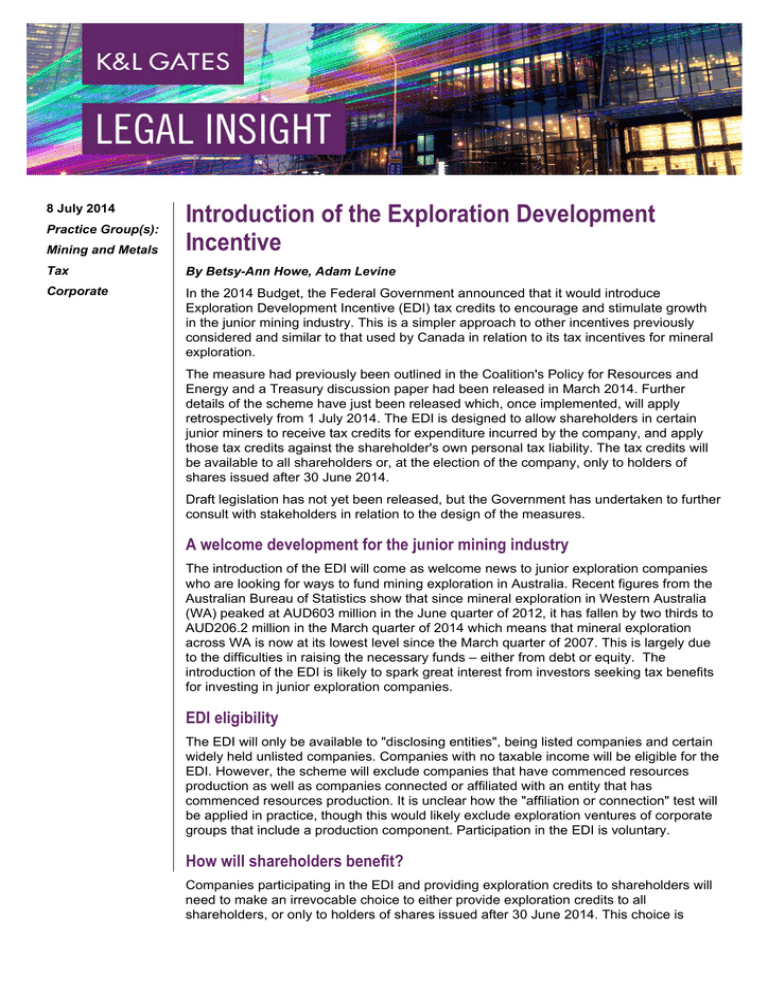
Mining and Metals
Introduction of the Exploration Development
Incentive
Tax
By Betsy-Ann Howe, Adam Levine
Corporate
In the 2014 Budget, the Federal Government announced that it would introduce
Exploration Development Incentive (EDI) tax credits to encourage and stimulate growth
in the junior mining industry. This is a simpler approach to other incentives previously
considered and similar to that used by Canada in relation to its tax incentives for mineral
exploration.
8 July 2014
Practice Group(s):
The measure had previously been outlined in the Coalition's Policy for Resources and
Energy and a Treasury discussion paper had been released in March 2014. Further
details of the scheme have just been released which, once implemented, will apply
retrospectively from 1 July 2014. The EDI is designed to allow shareholders in certain
junior miners to receive tax credits for expenditure incurred by the company, and apply
those tax credits against the shareholder's own personal tax liability. The tax credits will
be available to all shareholders or, at the election of the company, only to holders of
shares issued after 30 June 2014.
Draft legislation has not yet been released, but the Government has undertaken to further
consult with stakeholders in relation to the design of the measures.
A welcome development for the junior mining industry
The introduction of the EDI will come as welcome news to junior exploration companies
who are looking for ways to fund mining exploration in Australia. Recent figures from the
Australian Bureau of Statistics show that since mineral exploration in Western Australia
(WA) peaked at AUD603 million in the June quarter of 2012, it has fallen by two thirds to
AUD206.2 million in the March quarter of 2014 which means that mineral exploration
across WA is now at its lowest level since the March quarter of 2007. This is largely due
to the difficulties in raising the necessary funds – either from debt or equity. The
introduction of the EDI is likely to spark great interest from investors seeking tax benefits
for investing in junior exploration companies.
EDI eligibility
The EDI will only be available to "disclosing entities", being listed companies and certain
widely held unlisted companies. Companies with no taxable income will be eligible for the
EDI. However, the scheme will exclude companies that have commenced resources
production as well as companies connected or affiliated with an entity that has
commenced resources production. It is unclear how the "affiliation or connection" test will
be applied in practice, though this would likely exclude exploration ventures of corporate
groups that include a production component. Participation in the EDI is voluntary.
How will shareholders benefit?
Companies participating in the EDI and providing exploration credits to shareholders will
need to make an irrevocable choice to either provide exploration credits to all
shareholders, or only to holders of shares issued after 30 June 2014. This choice is
Introduction of the Exploration Development Incentive
intended to allow the company to decide which option best assists it in continuing to
explore for new mineral deposits.
Where an entity elects to provide exploration credits to holders of shares issued after 30
June 2014, any shares issued by the entity after 30 June 2014 will need to be traded as a
separate class of shares given that the rights and restrictions attaching to shares issued
after 30 June 2014 will be different to the entity's other classes of shares. In order for the
separate class of shares to be quoted and traded on the Australian Securities Exchange
(ASX), the entity will need to apply to ASX for the quotation of the securities and meet the
relevant conditions set out in the ASX Listing Rules.
Administratively, an entity will need to maintain adequate records of those shareholders
who are entitled to receive tax credits under the EDI.
What expenditure will be eligible?
The EDI will apply to eligible greenfields exploration expenditure incurred from 1 July
2014. This will broadly include expenditure incurred on activities for the purpose of
determining the existence, location, extent or quality of a new mineral resource in
Australia on land the subject of an exploration licence.
So that the definition does not extend beyond greenfields exploration, the definition would
not include expenditure on activities normally associated with feasibility, including
activities aimed at determining whether it is economically (including technically) feasible
or commercially viable to proceed to development, or how best to develop a known
mineralisation, would be excluded from the EDI.
Specifically, activities covered will include geological mapping, geophysical surveys,
systematic search for areas containing minerals, except petroleum or quarry materials,
and search for minerals by drilling or other means for such minerals within those areas.
The EDI will only apply to expenditure on exploration for minerals in Australia and will not
apply to exploration for:
• quarry materials
• shale oil
• petroleum, including coal seam gas, and any naturally occurring hydrocarbon or
naturally occurring mixture of hydrocarbons, whether in a gaseous, liquid or solid state
• geothermal energy resources.
Capping the EDI
As announced in the 2014 Budget, Government expenditure in relation to EDI credits will
be capped at AUD25 million for exploration expenditure incurred in 2014, AUD35 million
for exploration expenditure incurred in 2015-16 and AUD40 million for exploration
expenditure incurred in 2016-17. In order to ensure the caps are not breached, an "expost modulation approach" will be applied by the Australian Taxation Office (ATO).
In broad terms an ex-post modulation would require companies to notify the ATO of their
‘eligible loss’ and eligibility for the scheme in respect of the previous financial year (the
expenditure year), and lodge their tax return by a cut-off date, for instance 1 March
following the expenditure year. The ATO would then calculate the total ‘eligible losses’
reported for the expenditure year. If the total exploration credits that would result from the
‘eligible losses’ exceed the cap set by the Government for the expenditure year, the ATO
would calculate an appropriate modulation factor (so that the cap is not exceeded) and
2
Introduction of the Exploration Development Incentive
advise eligible companies of the proportion of their ‘eligible losses’ they will be entitled to
provide to shareholders as exploration credits.
Companies will not be able to flow through the benefit of more than their ‘available loss’,
that is, the modulation factor multiplied by their expenditure year ‘eligible loss’.
While this approach was considered to be the least administratively complex, and would
enable an earlier start to the EDI, it does mean that investors are unlikely to be able to
determine the quantum of the exploration credit if they were to invest in the expenditure
year unless they are able to reliably estimate both the company’s likely ‘eligible loss’ and
total ‘eligible losses’ for all eligible companies in that year.
Companies seeking to raise capital from investors on the basis that the funds will be
used for eligible greenfields exploration under the EDI and thereby offering tax credits to
such investors, will need to ensure that any offer document fully and adequately outlines
what the funds raised will be used for. For example, it is common that the proceeds of
funds are used for a variety of purposes including, exploration, capital expenditure and
the costs of the offer. If it is intended that the money raised from the capital raising will
fund costs other than exploration, investors will not be able to claim tax credits for such
expenditure as it is not eligible expenditure under the EDI. There will also need to be
proper disclosure in the fundraising documentation around the EDI regime.
It will be important for entities participating in the EDI to keep adequate, detailed and up
to date records of its eligible greenfield exploration expenditure including payments into
and out of its EDI accounts.
The treatment of exploration credits
Companies wishing to provide credits to shareholders will need to make adjustments to
tax losses by reducing the amount of the tax loss available to carry forward by an amount
equivalent to the credits it wishes to provide to its shareholders. In effect, the rules will
allow shareholders to realise the benefit of expenditure in the form of credits, as opposed
to the expenditure sitting in the company as a tax loss.
Australian resident shareholders will be entitled to refundable tax offsets equal to the
exploration credits they receive. However whilst foreign resident shareholders will also
receive the credits, they will not be entitled to use them. Exploration credits will flow
through trusts and partnerships in a manner consistent with the rules applying to franking
credits. Likewise, corporate shareholders will receive similar benefits to those they obtain
under the rules that apply to franking credits.
Contact Us
Please contact us with any questions or if you require advice in relation to the EDI and
what opportunities it may create for your company, its shareholders and potential
investors.
Authors:
Betsy-Ann Howe
betsy-ann.howe@klgates.com
+61.2.9513.2365
3
Introduction of the Exploration Development Incentive
Adam Levine
adam.levine@klgates.com
+61.8.9216.0965
Anchorage Austin Beijing Berlin Boston Brisbane Brussels Charleston Charlotte Chicago Dallas Doha Dubai Fort Worth Frankfurt
Harrisburg Hong Kong Houston London Los Angeles Melbourne Miami Milan Moscow Newark New York Orange County Palo Alto
Paris Perth Pittsburgh Portland Raleigh Research Triangle Park San Diego San Francisco São Paulo Seattle Seoul Shanghai
Singapore Spokane Sydney Taipei Tokyo Warsaw Washington, D.C. Wilmington
K&L Gates comprises more than 2,000 lawyers globally who practice in fully integrated offices located on five
continents. The firm represents leading multinational corporations, growth and middle-market companies,
capital markets participants and entrepreneurs in every major industry group as well as public sector entities,
educational institutions, philanthropic organizations and individuals. For more information about K&L Gates or
its locations, practices and registrations, visit www.klgates.com.
This publication is for informational purposes and does not contain or convey legal advice. The information herein should not be used or relied upon
in regard to any particular facts or circumstances without first consulting a lawyer.
© 2014 K&L Gates LLP. All Rights Reserved.
4




